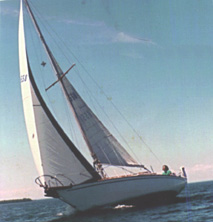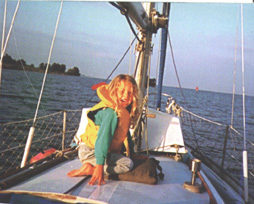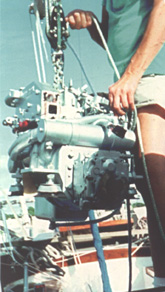
When is an Ericson Really an Alberg?
by Jerry Powlas
From Good Old Boat magazine, September/October 1998, Volume 1, Number 2, page 28.
Reprinted with permission.
 The Ericson 35 handles well under sail and fully loaded. |
When he saw the Ericson 35 that would later be christened the Catherine L, Dan Haupert believed he'd found the Alberg of his dreams. "I always loved the Albergs," he says. "They're the most sensible boats."
Although we haven't found substantiation for this story, Dan believes Pearson sold the 35-foot mold to Ericson which then had Bruce King design a new deckhouse and develop a different rudder. To him, his Ericson hull #19 is an Alberg 35, Dan says, but with a different deckhouse, rudder and a three-inch bulwark. "It's a beautiful boat," he continues, "and aesthetics are a good part of sailing, but it's not good for punching into seas. It was a CCA racing rule-beater design at the time, and it's very pretty." One limitation, he says, is that "she's got a 24-foot waterline on a 35-foot boat." |
|
|
While she's narrow and small inside for a family of three, Dan says they can load Catherine L up for cruising, and she retains her sailing characteristics while "many fin-keelers get dangerous as you load them up," he notes. And people will load them up when cruising as the Hauperts do. "It's unbelievable the stuff you need to be safe when you're living aboard," he says.
The boat's long overhang at the stern gives her reserve buoyancy, Dan says. "You see a wave coming and think you're going to get clobbered. Then she rises up, and the wave goes under and past." In the Caribbean, the Hauperts have been in enough heavy seas to test and swear by sterns with a long overhang. |
|
|
Tiller steering a plus
Unlike modern boats in the 35-foot range, the Catherine Lis equipped with a tiller. Dan says he wouldn't trade that feature. For one thing, it works well with the Aries windvane. "It's awe-inspiring to watch a windvane sail when it's working well," Dan says. "But it does require a perfect balance of sails and a lot of sea room." Unfortunately the Hauperts haven't been able to use the windvane a great deal in their travels, because they haven't had enough sea room when making island hops. An autopilot steers a closer course, Dan notes, saying the windvane steers within plus or minus 10 degrees and requires at least 15 knots of wind to make it work well. When it's too rough for the boat's Navico Tiller Pilot, the Aries begins to come into its own, he says. The Hauperts believe the Catherine L was sponsored by CBS in a Chicago-Mackinac race. She still owns a spinnaker which sports an enormous CBS eye logo. The spinnaker hasn't been very handy in the Hauperts' Caribbean cruises. Light air is a rare occurrence, and downwind sailing is a novelty. |
| Because the Catherine L was raced, the previous owners had installed an 18-inch bowsprit to lengthen the foretriangle. Dan converted it for cruising by adding anchor rollers and a windlass. The larger foretriangle may also have solved a weather helm problem caused by the way she was originally rigged. "She handles very well now," Dan says, "She loses some light-air performance, but there isn't much light air in the Caribbean in the winter when we're there. We always have too much."
|
 Mara enjoys the onboard lifestyle. |
Equipment that counts
The Catherine L is sloop-rigged. She normally carries a 100-percent Genoa on the Harken roller furler and has a 150-percent jib reserved for light air and downwind sailing. Dan installed a removable inner forestay and running backstays for use in heavy weather. The staysail is balanced by the third reef in the main, which he says brings the main to the size of a storm trysail.
Dan and Cathy bought the Catherine L a head sail and the main through sail brokers Atlantic Sail Traders. (For more on sail brokers see article on Page 44.) They had to recut the jib to make it fit, but the main was a perfect match. Dan is very appreciative of the services offered by sail brokers, saying, "You get good sails for not a whole lot of money."
Other heavy weather equipment on the Catherine L includes a storm jib, a sea anchor, and a Jordan series drogue -? none of which have been used. He describes this gear as "downwind and catastrophic" and adds that they simply haven't sailed downwind much.
Auxiliary power is important on the "thorny path" (cruising primarily against the wind between Florida and the Virgin Islands), Dan notes.
"People spend much of their time in anchorages waiting for a norther to dampen the trades," he says. In many cases they simply motor upwind.
"Even when you're a sailboat, make no mistake about it," he says, "you're motoring a lot of the time to get to the ocean." Unfortunately, the Ericson 35 is not a good motorboat," he says. "Sometimes, when beating on the thorny path, it would be good to turn on an engine and bash your way upwind." (The Hauperts note that if you're planning to make this trip, Bruce Van Sant's Gentleman's Guide to Passages South is required reading.)
The Catherine L started life as a racing boat with a direct-drive Atomic 4 and an 11-inch 2-bladed propeller. Dan and Cathy used the Atomic 4 for several seasons on Lake Superior and in her river and lock travels south. Dan says of the Atomic 4, "It was a wonderful engine when it ran well, but it had a way of going out on you in very inopportune moments." He adds that it could have gone easily for 100 years, if they had continued to stay in a marina, motor out, set sails, and not turn it on again until it was time to return to a slip. But that's not the kind of sailing they're doing these days.
Engine conversion
|
|
The Atomic 4 was using a gallon of gas an hour in a flat calm, Dan notes, and the boat has an 18-gallon fuel tank to which Dan added four 5-gallon jerry jugs. Once they arrived in the Florida panhandle and were facing a 150-mile passage to Tarpon Springs, Dan knew that if the wind died, they'd reach the outer limits of fuel capacity for the Atomic 4. They didn't like the idea of jerry cans full of gasoline sitting around on deck, and enough things had gone wrong with the engine to cause them to lose faith in it. Before setting out on their second season, they put in a diesel engine.
|
Dan researched the engine choices and settled on a Universal M25XP, which he says is a marinized Kubota. He selected it because theoretically it fit in the existing mounts, he says, but the engine in fact took up more space on the flywheel end than the Atomic 4, necessitating modifications? particularly to the companionway ladder.
Dan estimates that the conversion cost $5,000 including the new prop and shaft. He adds, however, that he did all the work himself. And he guesses that he may have spent 150 hours on the project. It took the better part of a month in the yard, he says, adding succinctly, "It's a project." He notes that the Universal Mini 3 or Mini 4 might have taken fewer hours of his time and cost about the same amount.
The new diesel engine had a reduction gear, so the Catherine L now has a 13 x 15 three-bladed prop. The prop shaft was too long and worn at the cutlass bearing, so Dan replaced it.
Cruising gear
In addition to the engine-driven alternator, the Catherine L has one 20-watt solar panel. They can anchor for a month at a time, he says, and never turn the engine on. They don't rely on refrigeration, so their electrical needs are minimal. "It's incredible what people will do to have ice in their drinks." Dan says, "One boat we know runs the engine three hours each morning and three hours each afternoon." Then he points out that others with refrigerators still go to town to buy ice, which they use to assist the refrigerator. "It's absurd," he concludes.
The Hauperts also have elected to live without a desalinator. The Catherine L was built with 35 gallons of water storage capacity, and Dan added two 15-gallon tanks in the bilge. They also carry four five-gallon jerry jugs and gather rainwater. The Catherine L's three-inch bullwarks make a natural rainwater trap. Dan installed a thru-hull with a two-way valve where the starboard bulwark drains.
They let the decks rinse clean; then they capture the rainwater by turning a valve which is conveniently located inside the cabin near the quarterberth. The family uses three gallons of water a day. He adds that water is generally available in the Caribbean, but they've heard that it gets harder to find as cruisers move farther south. They did go six weeks without rain one time in the Bahamas, but those stretches are rare.
Advice
Since Dan was once our personal dockmate and sailing guru, we asked him to offer advice for other sailors with similar dreams. He said the smartest thing in buying boats is to get one with everything on it... in other words a fully loaded good old used boat. He also advises people to do the work themselves so they know what's on there and how to fix it. "I've seen people out there with more money than brains," he says. "When something goes wrong, they don't have a clue."
And he advises other sailors not to be intimidated. Have safety gear aboard, and be aware of what your boat can handle. "It's a mental thing," he says. "Get a basis of experience behind you so when things intensify, they're not as shocking, and you can deal with them. Read and learn vicariously from other sailors." He adds as an afterthought, "Wait for bad weather to improve."
Specifications
LOA 34' 9"
LWL 24' 1"
Beam 9' 8"
Draft 5' 1"
Headroom 6' 5"
Displacement 12,000 lbs.
CCA Rating 24.7
Sail Area 544 ft2 (100% foretriangle, unmodified)
Ballast 5,300 lbs.
Fuel 18 gal.
Water 65 gal.
Resources for Ericson and Alberg Sailors
Ericson 27 (California)
1220 Seville Drive
Pacifica, CA 94044
415-359-9178
Ericson 27 Class Association (Chesapeake Bay area)
John Stuhdreher
This email address is being protected from spambots. You need JavaScript enabled to view it.
John is interested in locating other Ericson 27 owners in the Chesapeake Bay area or in starting an owners' association for Ericson 27s in the area.
Ericson 27 Fleet One
Amy Lee
This email address is being protected from spambots. You need JavaScript enabled to view it.
$15 a year to join. The group produces an owners' manual and a newsletter. It also sponsors races, cruises, and events. (We know this group is out there, but it seems that Amy changed her email address recently. If you know how to locate this group, please let us know.)
Ericson 29 Class Association
Greg Delozier
1675 Ridgewood
Wadsworth, OH 44281
330-668-2267 (days)
This email address is being protected from spambots. You need JavaScript enabled to view it.
Greg is interested in locating other Ericson 29 owners or in starting an owner's association for Ericson 29s.
Also:
Peter Stryker
This email address is being protected from spambots. You need JavaScript enabled to view it.
Also interested in locating other Ericson 29 owners or in starting an owners' association for Ericson 29s.
Ericson 32
Cory Bolton
This email address is being protected from spambots. You need JavaScript enabled to view it.
Cory would like to hear from and share information with other Ericson 32 owners.
Ericson 35 Class Association
This email address is being protected from spambots. You need JavaScript enabled to view it.
Interested in locating other Ericson 35 owners or in starting an owners' association for Ericson 35s.
Ericson 39 (flush deck)
Mike Stanich
642 Marina Pkwy, #51
Chula Vista, CA 91910
619-476-8081 (days or evenings)
This email address is being protected from spambots. You need JavaScript enabled to view it.
Mike would like to hear from and share information with other Ericson 39 owners.
Ericson Class Association (Northwest Branch)
Max Heller
This email address is being protected from spambots. You need JavaScript enabled to view it.
Max is interested in locating other Ericson owners in the Northwest or in starting an owners' association for Ericsons in the Northwest region.
Ericson Email Discussion List
http://www.sailnet.com/list/ericson/index.htm
Ericson Newsletter (Northeast Ericson News)
Jeff and Linda Lennox
18 White Birch Court
Shelton, CT 06484
203-452-3100 (days)
This email address is being protected from spambots. You need JavaScript enabled to view it.
Jeff and Linda publish a quarterly newsletter for Ericson owners in the Northeast U.S. (Maine to Virginia). To be added, contact them with name, mailing address, boat model, year of manufacture, and name of boat.
Alberg Class Association
Ken Stephenson
This email address is being protected from spambots. You need JavaScript enabled to view it.
Members own and sail Alberg 29s, 30s, and 37s.
Alberg 30 Association (Great Lakes)
Rick Kent
170 Grenadier Road
Toronto, Ontario
Canada, M6R 1R4
Alberg 30 Class Association (Chesapeake Bay)
George Dinwiddie
226 Beachwood Road
Pasadena, MD 21122
This email address is being protected from spambots. You need JavaScript enabled to view it.
http://www.alberg30.org
This group prints a monthly newsletter, The Mainsheet. It also holds annual winter seminars in February and sailing events from April to November on Chesapeake Bay. Members published a maintenance manual for the Alberg 30. The group has members from California to British Columbia, Texas to Maine, both sides of the Great Lakes and a few in the interior of the U.S.
Alberg 35 Home Page
Tom Alley
This email address is being protected from spambots. You need JavaScript enabled to view it.
http://www.alberg35.org/





